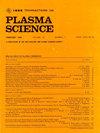Parameter Dependences of Ion Energy Distribution and Ion Flux in Dual-Frequency Capacitively Coupled Argon Discharges
IF 1.5
4区 物理与天体物理
Q3 PHYSICS, FLUIDS & PLASMAS
引用次数: 0
Abstract
Low-pressure dual-frequency capacitively coupled plasmas (DF CCPs) are routinely used in high-aspect-ratio (HAR) dielectric etching for 3-D memory fabrication, due to their capability for independent control of ion flux and ion energy. To prevent unwanted etching profiles caused by the charging effect inside the HAR trenches, a much lower excitation frequency, in the kilohertz range, is necessary to generate higher ion energy. In this work, we investigate the effects of discharge parameters on the ion energy distribution function (IEDF) and the ion flux in a DF argon discharge excited by a high-frequency (HF) source at 27.2 MHz and a low-frequency (LF) source at 0.04/0.4/1.36/2.72/5.44/6.8 MHz, utilizing a retarding field energy analyzer (RFEA). With increasing the LF voltage amplitude (双频电容耦合氩放电中离子能量分布和离子通量的参数依赖性
低压双频电容耦合等离子体(DF ccp)由于能够独立控制离子通量和离子能量,通常用于3d存储器制造的高宽高比(HAR)介质刻蚀。为了防止由HAR沟槽内的充电效应引起的不必要的蚀刻轮廓,需要在千赫兹范围内的低得多的激发频率来产生更高的离子能量。本文利用延迟场能量分析仪(RFEA)研究了27.2 MHz高频(HF)源和0.04/0.4/1.36/2.72/5.44/6.8 MHz低频(LF)源激发的DF氩放电中,放电参数对离子能量分布函数(IEDF)和离子通量的影响。随着低电压幅值(${V}_{\text {L}}$)的增大,离子平均能量增大,而离子通量减小。离子通量相对于${V}_{\text {L}}$的减小是由于在较高的${V}_{\text {L}}$处HF电子加热减弱所致。IEDF由${V}_{\text {L}} =50$ V处的宽峰演变为${V}_{\text {L}} =100$ V处的双峰结构。随着${V}_{\text {L}}$的进一步增大,高能峰向高能量方向移动,高低能峰之间的能量宽度变宽。相反,增加高频电压幅值(${V}_{\text {H}}$)会导致平均离子能量和离子通量的增加。通过增加气体压力(p), IEDF中的高能峰和低能峰都变得不那么明显,这是由于在更高的p下离子和中性离子之间的动量传递和/或电荷交换碰撞增强。随着低频频率(${f}_{\text {L}}$)的增加,IEDF从宽双峰结构转变为几乎单峰结构。值得注意的是,随着${f}_{\text {L}}$的减小,离子通量先减小后增大,在400 kHz时达到最大值。
本文章由计算机程序翻译,如有差异,请以英文原文为准。
求助全文
约1分钟内获得全文
求助全文
来源期刊

IEEE Transactions on Plasma Science
物理-物理:流体与等离子体
CiteScore
3.00
自引率
20.00%
发文量
538
审稿时长
3.8 months
期刊介绍:
The scope covers all aspects of the theory and application of plasma science. It includes the following areas: magnetohydrodynamics; thermionics and plasma diodes; basic plasma phenomena; gaseous electronics; microwave/plasma interaction; electron, ion, and plasma sources; space plasmas; intense electron and ion beams; laser-plasma interactions; plasma diagnostics; plasma chemistry and processing; solid-state plasmas; plasma heating; plasma for controlled fusion research; high energy density plasmas; industrial/commercial applications of plasma physics; plasma waves and instabilities; and high power microwave and submillimeter wave generation.
 求助内容:
求助内容: 应助结果提醒方式:
应助结果提醒方式:


